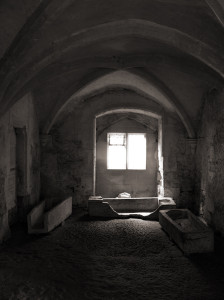Over the past year we have been running a monthly British History Online photo competition. All those photos added to our Flickr group in the previous month have been entered into a pool and scrutinised by my judicious and sharp-eyed colleagues in IHR Digital. I then aggregated all the votes to produce a shortlist, which was then further voted upon by British History Online’s academic advisory group.
This month we had two runners-up, in no particular order. One was Fountains Abbey by a veteran of the photo competition, Bill Tennent, the frantic-photographer:
This kind of geometrical, receding composition is a tricky one for any photographer and Bill has done a great job of giving us a sense of depth and space while keeping everything in balance. I also like the somewhat eerie bright green walls and column bases.
By contrast, our other runner-up is a monochrome photograph: Lacock Abbey by Tevor Hare:
Almost everything we can see in this photograph is, or appears to be, stone – except that out-of-place window, with the light streaming through. Particularly evocative are the empty coffins, perhaps brought from elsewhere, their contents presumably scattered or reburied.
who knows the fate of his bones, or how often he is to be buried? Who hath the oracle of his ashes, or whither they are to be scattered?
Thomas Browne, Hydrotaphia, Urn Burial
The prize is that the winning photo has the glory of appearing on our British History Online homepage for a month. Our last winner, now in that prestigious position, is The Paris House at Woburn, by Jason Ballard:
The Paris House, although clearly in the English style, was built in Paris for an international exhibition on architecture held in 1878. It was designed by Gilbert Redgrave and was actually prefabricated and constructed on the site – although it is a bit more elegant than the prefabricated classrooms of my school days. It now stands in Woburn Park, and Jason has caught the character of the house and its surroundings beautifully, including the quintessentially English greens of a country that receives a healthy amount of rainfall.
It is appropriate (although entirely coincidental) that the house stands on the Duke of Bedford’s estate, because he liked it so much he had it shipped to England. The Institute of Historical Research (and the entire central University of London) also stands on estates owned by the dukes of Bedford. Most of the roads around our offices are named after members of the family: Russell Square, Woburn Place, Malet Street, Bedford Square…
We’ve very much enjoyed judging the photo competition over the past year, and we’d like to thank everyone who contributed photos to the group. Anyone is welcome to continue adding to the Flickr group, if they’d like to.



